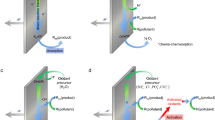Abstract
This paper presents a mathematical model of a batch stirred-tank electrochemical reactor where a required cathodic reduction reaction is coupled with a complex reaction sequence between the reactant and the key product. The set of coupled, non-linear differential equations is solved numerically and simple dimensionless quantities characterizing the cell performance and selectivity are derived. The experimental results presented in Part I of this paper are found to be in excellent agreement with the model. In the particular case where the homogeneous chemical reactions may be neglected in the cathodic diffusion boundary layer, a simplified analytical expression of the process selectivity is proposed. This quantifies the effects of the operating conditions by means of a single dimensionless criterion.
Similar content being viewed by others
Abbreviations
- A e :
-
electrode area
- a e :
-
specific electrode area
- C A,C B,C C :
-
molar concentrations of species A, B, C
- C AS,C BS,C CS :
-
bulk molar concentrations
- C AO :
-
initial concentration of species A
- C +A ,C +B :
-
reduced concentrations (with respect toC AS-section 2)
- C +AO ,C +BO :
-
reduced concentrations (with respect toC AO)
- C *BS :
-
=C BS/C AS
- C +AS, i ;C +BS, i :
-
bulk concentrations in thei th reactor normalized with respect toC AO
- D A,D B :
-
molecular diffusion coefficients
- D +B :
-
=D B/D A
- E :
-
electrode potential
- F :
-
Faraday's constant
- Ha 0,Ha :
-
Hatta numbers defined with respect toC AO orC AS
- i :
-
current density
- i L :
-
limiting current density
- i * :
-
dimensionless current density (Equation 6)
- k ci :
-
chemical rate constants involved in scheme I
- k c :
-
chemical rate constant of scheme II
- k d :
-
mass transfer coefficient
- K 1,K 2 :
-
dimensionless parameters defined in Equation 13
- K :
-
dimensionless parameter defined in Equation 17
- N :
-
impeller rotation speed
- Q v :
-
volumetric flowrate
- r i :
-
chemical reaction rate
- R A :
-
conversion factor of species A
- S :
-
product selectivity
- T :
-
temperature
- t :
-
time
- t + :
-
dimensionless time=t(k d a e)
- V :
-
volume of catholyte
- X A,X B,X C :
-
molar fractions, i.e.C AS/C AO;C BS/C AO;C CS/C AO
- y :
-
coordinate perpendicular to the electrode
- y + :
-
reduced coordinate=y/δ
- v e :
-
number of electrons involved in the reduction
- τ:
-
space time
- f:
-
final
- L:
-
limiting
- 0:
-
initial (time=0)
- S:
-
in the bulk of the electrolyte
References
L. Weise, G. Valentin and A. Storck,J. Appl. Electrochem. 16 (1986) 836.
R. C. Alkire and J. D. Lisius,J. Electrochem. Soc. 132 (1985) 1879.
P. V. Danckwerts, ‘Gas-Liquid Reactions’, Mc-Graw Hill, New York (1970).
J. C. Charpentier and G. Wild, ‘Absorption avec réaction chimique’, Technique de l'Ingénieur, J2640-12, Paris (1983).
W. H. Ray and J. Szekely, ‘Process Optimization’, John Wiley and Sons, New York (1983).
J. Villermaux, ‘Génie de la Réaction Chimique’, Technique et Documentation, Lavoisier, Paris (1982).
Author information
Authors and Affiliations
Rights and permissions
About this article
Cite this article
Weise, L., Valentin, G. & Storck, A. Selectivity analysis in electrochemical reactors. II. Engineering models of a batch reactor with a complex reaction sequence. J Appl Electrochem 16, 851–866 (1986). https://doi.org/10.1007/BF01006530
Received:
Revised:
Issue Date:
DOI: https://doi.org/10.1007/BF01006530




